American cameras rarely get much love from collectors. For every Kodak Medalist or Bell & Howell Foton, there were a ka-jillion cheap Brownie and Instamatic cameras with plastic lenses, single speed shutters, and a list of features that can often be counted on one hand.
With sites like mine, there is a great deal of information today about some of the better American cameras produced over the past 100+ years that can hopefully change some people’s opinions on them. Models like the Kodak Signet 35, ANSCO Automatic Reflex 3.5, and Zenith Winpro 35 which deliver results way above their price tag, show that just because a camera was “Made in the USA” doesn’t mean it’s not worth adding to your collection.
Back in 1976, Japanese cameras and lenses were the king of the industry. With long time German names like Zeiss, Voigtländer, and AGFA no longer producing new models, if you wanted anything from an inexpensive point and shoot to a top of the line SLR, most people bought a Japanese brand. For someone new to photography back then, it was reasonable to assume that the United States never made good cameras, so perhaps it was time for someone to remind them that at one time not that long ago (in 1976 that is) American companies made some pretty good models too.
This week’s Keppler’s Vault brings you an article from the May 1976 issue of Camera 35 magazine, which no doubt was timed to coincide with the United States bicentennial that same year. Although the article is relatively short, it does a good job of reminding people that there were tons of cameras like the Argus C3, Clarus MS-35, and Perfex Fifty-Five still to choose from for not a lot money.

These cameras of course lacked any sort of electronic automation that was common by 1976, but all had rangefinders and interchangeable lens mounts that could deliver good results on a budget. The article does a good job of getting the point across that these cameras were then, and still were a value proposition, but gets a little loose with the facts suggesting these cameras could originally be had for as little as $25, when only the Argus C and C2 ever sold for that price and only for one year. Upon it’s release in 1939, the Argus C3 carried a $5 premium over the C2, but that only applied to the camera’s first year as the price of the C3 quickly rose after it’s release. Selling for $45 in 1942 and $78 in 1949, even used Argus C3s back then likely cost more than $25. The Perfex and Clarus were even more expensive, with the Clarus selling with an f/2.8 or f/2 Wollensak lens for $116.25 and $168.50 respectively.
I wish the article was longer and went into more detail about some other great American cameras made over the years. I have to imagine that by 1976, the idea that American cameras weren’t worth your time was already prevalent, so without a good resource to share information regarding some of the better cameras, I can’t help but feel like this short article missed a good opportunity, especially being published in the year of this country’s bicentennial.
Forty-five years have passed since then, and thankfully I am here to take that opportunity and present to you 10 great 35mm cameras made in the USA. For this list, the cameras must have been built in the USA, and not in another country for an American company. For obvious reasons, this excludes all Kodak Retinas, not that anyone needs to make another list about how good Retinas are. I also didn’t include cameras like the Ektra or Foton which are impossibly rare and expensive to find today. Finally, for cameras that were part of a series, I only selected one example from that series to eliminate variants.
Here’s my list in alphabetical order, of American made 35mm cameras you should consider adding to your collection.
Ansco Memo (1927)
The ANSCO Memo is the oldest camera on this list and the only one that wasn’t designed for Kodak’s daylight loading 35mm cassette. The Memo originally used a special kind of 35mm film that came in it’s own unique cassette, but the film is exactly the same as what you can get today, so as long as you can find a camera with two empty cassettes, it can be reloaded in darkness.
The Memo is an attractive and compact wooden box camera that came with a variety of lenses and shutters, but even with the most basic combination, is capable of excellent results. It shoots 18x24mm “half frame” images, but the film transports through the camera vertically, meaning all shots have a natural landscape orientation.
The large and very easy to use viewfinder is MUCH larger than most 35mm cameras of the era and with it’s simple operation, is very easy to shoot and as an added bonus, because it’s so simple, there’s little to go wrong as most of these can still be found in good condition today.
Argus C3
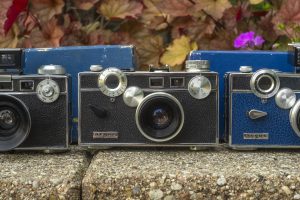 The Argus C-series was in production from 1938 through 1966, although the first C3 didn’t debut until 1939, the entire series is the longest running American made camera ever.
The Argus C-series was in production from 1938 through 1966, although the first C3 didn’t debut until 1939, the entire series is the longest running American made camera ever.
Millions of C3s were sold because of their simple operation, low price, rugged build, and excellent results. An interchangeable lens rangefinder, most C3s were used with it’s 50mm Cintar lens, which was a very capable lens, but for the photographer who wanted a little more range, could have lenses from 35mm to 135mm.
The Argus C3 was extremely popular with American families in the mid 20th century and likely did more to popularize Kodak’s iconic Kodachrome film than any single Kodak model.
There are those today who chastise the C3 for it’s brick like shape and poor ergonomics, but by all accounts, that didn’t seem to be much of a problem back then as the C3 outlived many other, more technically capable cameras, staying in production longer than many more modern Argus models.
Argus C44R
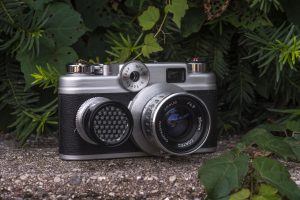 Speaking of more modern Argus cameras, one of their best was the Argus C44 from 1956 and the slightly improved Argus C44R two years later. Like the C3, the C44R was an interchangeable lens rangefinder camera, but was much improved with a new bayonet lens mount, a larger, combined, coincident image rangefinder, rapid wind and rewind levers, a selectable M and X flash hot shoe, and support for an optional coupled selenium exposure meter.
Speaking of more modern Argus cameras, one of their best was the Argus C44 from 1956 and the slightly improved Argus C44R two years later. Like the C3, the C44R was an interchangeable lens rangefinder camera, but was much improved with a new bayonet lens mount, a larger, combined, coincident image rangefinder, rapid wind and rewind levers, a selectable M and X flash hot shoe, and support for an optional coupled selenium exposure meter.
The C44R offered all of the modern rangefinder features found on many other, much more expensive German and Japanese models, but at a price that was more attainable for a modest American family.
In addition to a longer list of features, the C44R had much improved ergonomics making it much easier and more comfortable to use. Whether you had the standard 50mm Cintar lens, or one of the excellent wide or telephoto lenses, the C44R was a capable camera with a great lens that was reliably built.
Bolsey B2
 The Bolsey B2 was designed by Jacques Bolsey, the same guy who also created the Alpa Reflex SLR. Now as an American immigrant, Bolsey turned his talents into making a compact, but still capable camera that would bear his name. The second version of the Bolsey camera, called the B2, turned out to be the most successful, staying in production for over seven years.
The Bolsey B2 was designed by Jacques Bolsey, the same guy who also created the Alpa Reflex SLR. Now as an American immigrant, Bolsey turned his talents into making a compact, but still capable camera that would bear his name. The second version of the Bolsey camera, called the B2, turned out to be the most successful, staying in production for over seven years.
Featuring a fixed Wollensak 44mm lens and Alphax leaf shutter, a coupled split image rangefinder, and features like flash synchronization, double image prevention, and automatic film stop, the Bolsey B2 had just enough features to give the photographer what he or she needed to get the perfect shot, without making the camera bigger or overly complex.
The Bolsey B2 sold well enough that finding them today is still pretty easy. The cameras are attractive, compact, and well built and apart from usually needing a cleaning and a common oxidation that plagues the alloy bodies, can often still be used today.
Clarus MS-35
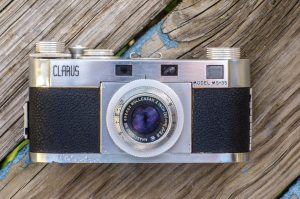 Immediately after the war, getting cameras from Germany was not possible, so there quickly became a huge demand for similar products that needed to be filled by American companies. Established companies like Kodak and Argus took the charge, so did new companies like Minneapolis, Minnesota based Clarus who promised an all new 35mm rangefinder that would have a coupled rangefinder, interchangeable lenses, a hot shoe, in an all new body design that wouldn’t simply look like a copy of the German Leica.
Immediately after the war, getting cameras from Germany was not possible, so there quickly became a huge demand for similar products that needed to be filled by American companies. Established companies like Kodak and Argus took the charge, so did new companies like Minneapolis, Minnesota based Clarus who promised an all new 35mm rangefinder that would have a coupled rangefinder, interchangeable lenses, a hot shoe, in an all new body design that wouldn’t simply look like a copy of the German Leica.
When it was released, the Clarus MS-35 met all of the company’s promises, but Clarus quickly found out that designing a precision instrument like a camera without any prior experience was easier said than done, as the camera had many reliability problems.
Later examples of the camera fixed the reliability issues, but by then, German models had re-entered the market, along with a huge number of competing American brands, so the Clarus MS-35 struggled to find buyers and eventually caused the company that made it to go out of business.
Although not common today, when found in working condition, Clarus MS-35s are really well built cameras with a competitive feature set and great lenses, making them excellent shooters.
Kodak 35
 Despite being an American company and standardizing the type 135 Daylight Loading 35mm cassette, it would be almost five years before an American Kodak camera would be built that used the film. The aptly named Kodak 35 is a simple camera with a fixed lens, leaf shutter, a flip up viewfinder, and not much else.
Despite being an American company and standardizing the type 135 Daylight Loading 35mm cassette, it would be almost five years before an American Kodak camera would be built that used the film. The aptly named Kodak 35 is a simple camera with a fixed lens, leaf shutter, a flip up viewfinder, and not much else.
In a case of “sometimes less is more”, the Kodak 35 was actually quite a capable camera with easy operation, good ergonomics, and a large and bright viewfinder that when equipped with the top of the line Kodak Anastigmat Special f/3.5 lens, was capable of excellent photography, so much so, that in my review for the Kodak 35, I declared it to be one of my all time favorite American cameras.
Sadly, this model’s reputation was somewhat tarnished by Kodak’s ill-advised attempt at improving the model with a rangefinder, turning that version of the camera into a hideous abomination with tiny viewfinders, and poor ergonomics. If you are looking for an American 35mm camera with a great lens, simple operation, and excellent reliability, go with the simpler non-rangefinder Kodak 35…
Kodak Signet 35
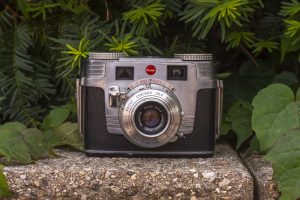 …and if you absolutely must have a rangefinder, jump ahead to the post war Kodak Signet 35, which for my money, is the best American 35mm rangefinder camera ever made.
…and if you absolutely must have a rangefinder, jump ahead to the post war Kodak Signet 35, which for my money, is the best American 35mm rangefinder camera ever made.
My reasoning for liking the Signet 35 so much is that it has a perfect balance of a large and bright coincident image rangefinder, oversized controls that are incredibly easy to use, both while wearing gloves and without, and because of it’s excellent 4-element Ektar 44mm f/3.5 lens.
The Signet 35 is one of the only cameras ever made that has a coupled rangefinder that can focus as close as 2 feet, something cameras like the Leica and Contax can’t do.
Sure, it has a rather limited range of shutter speeds and a fixed lens, but when used to it’s strengths, the Signet 35 is extremely fun to use and difficult to put down, plus a ton of them were made, so it’s not hard to find one for a cheap price today, making it an incredible value as well.
Mercury II
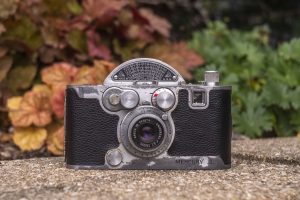 One thing that you can say about most American cameras is that they have a distinctly American look. Looking at the cameras on this list, none of these are copies of any other models, and have their own design. But of all the distinctly American looking cameras, there is one that is more distinct than the rest, and that is the Universal Mercury and it’s postwar version the Mercury II.
One thing that you can say about most American cameras is that they have a distinctly American look. Looking at the cameras on this list, none of these are copies of any other models, and have their own design. But of all the distinctly American looking cameras, there is one that is more distinct than the rest, and that is the Universal Mercury and it’s postwar version the Mercury II.
Featuring a prominent hump on the camera’s top plate that hides the Mercury’s unique rotary focal plane shutter, many people refer to the Mercury as the “parking meter camera”.
Designed by a company more known for making cinema cameras, Universal Camera took it’s knowledge of rotary shutters, and created a design that worked in a still camera. With it, they added an interchangeable lens mount, and one of the first appearances of a flash hot shoe on a still camera, and wound up with the Mercury.
The pre-war Mercury cameras used a proprietary film that couldn’t be sourced after the war, so the post war Mercury II was updated to support Kodak’s daylight loading 35mm cassette. Although you can still adapt pre-war models with regular 35mm film, it requires jumping through a couple hoops, making the Mercury II the better option.
With a look (and a sound) unlike any other camera ever made, it would be a disservice to talk about 10 American cameras wtihout mentioning the Mercury!
Perfex Fifty-Five
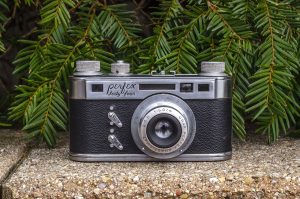 The Perfex Fifty-Five was the best featured of Perfex’s entire lineup of 35mm cameras, but has the unfortunate distinction of being bookended by some of the company’s worst cameras. The original Perfex Speed Candid was an ergonomic nightmare and very difficult to use, and Perfex’s last post war cameras were stripped down shells of their prewar cameras, with fixed lenses, leaf shutters, no rangefinders, and cheaply constructed stamped metal bodies.
The Perfex Fifty-Five was the best featured of Perfex’s entire lineup of 35mm cameras, but has the unfortunate distinction of being bookended by some of the company’s worst cameras. The original Perfex Speed Candid was an ergonomic nightmare and very difficult to use, and Perfex’s last post war cameras were stripped down shells of their prewar cameras, with fixed lenses, leaf shutters, no rangefinders, and cheaply constructed stamped metal bodies.
But there in the middle right before the war, Perfex seemed to be onto something with both the Forty-Four and Fifty-Five models which seemed to be on the trajectory of an American answer to the Leica. Supporting an interchangeable screw mount, a selection of good lenses, focal plane shutter with speeds up to 1/1250, a flash hot shoe, a coupled rangefinder with a very wide 90mm base, and models with an extinction meter, the Perfex Fifty-Five was an ambitious camera.
The company would struggle after the war however, quickly cheapening their products, and seeming to give up on the idea of building a camera capable of competing with the Germans, making the Fifty-Five an odd duck among American cameras. Not many were sold, but if you can find one today, they’re worthy of addition to your collection, and with a shutter that more cases than not still works OK, are still capable of excellent photos!
Revere 33
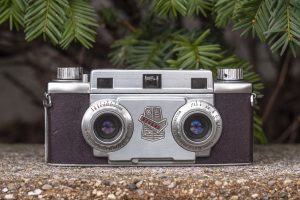 If I’m being fair, when it comes to 35mm stereo cameras, there were many great options from American camera makers. Kodak, TDC (Bell & Howell), The David White Company, Saywer’s (View-Master), and Revere all made excellent stereo cameras that deserve to be on this list.
If I’m being fair, when it comes to 35mm stereo cameras, there were many great options from American camera makers. Kodak, TDC (Bell & Howell), The David White Company, Saywer’s (View-Master), and Revere all made excellent stereo cameras that deserve to be on this list.
The Revere 33 is one of my favorites though as it has a coupled rangefinder, a wide range of shutter speeds, and excellent Wollensak lenses, plus it looks great.
Stereo photography saw a surge in popularity in the 1950s as life was returning to normal after the war for most Americans, and as people started families and went on vacations, they wanted to show off their travels. Kodachrome and other color transparent films were ideal for these types of cameras as stereo viewers and projectors became popular ways to show off your family photos in glorious 3D.
These cameras were not only great back then, but they were built well and can often be found today in good working order, plus, as I keep saying, they look cool. Perhaps the Revere 33 isn’t the camera for you, but as I mentioned above, if you want to get into the world of stereo 3D photography, there were a great number of American made options.
All scans used with permission by Marc Bergman, 2021.



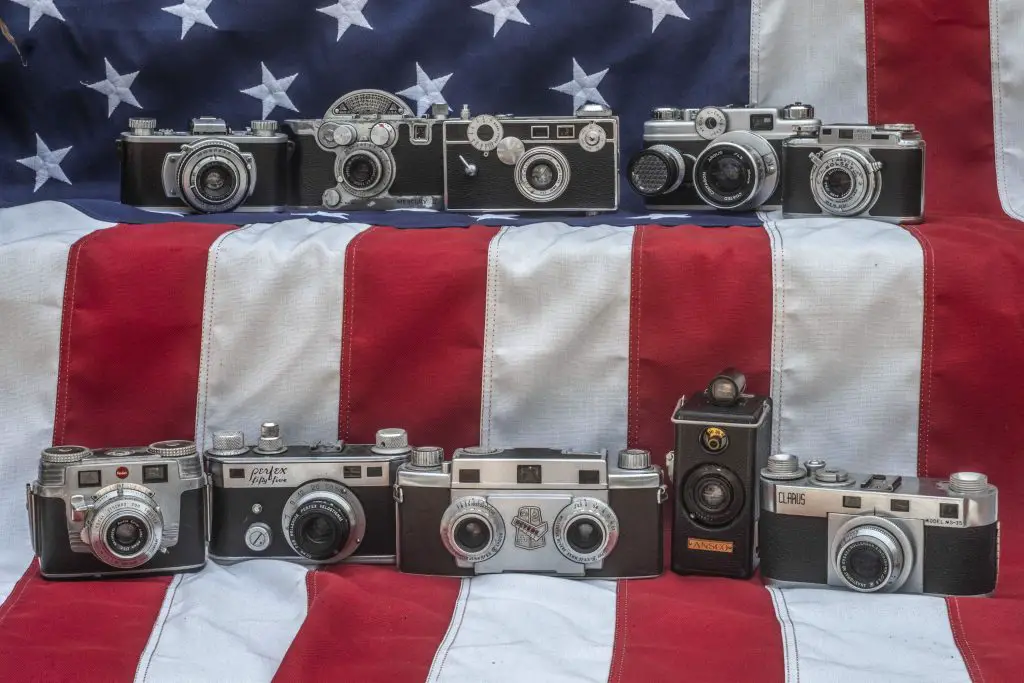
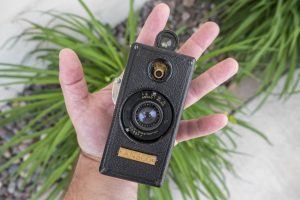
“GREAT” is an awful big word for a list of American 35mm cameras that doesn’t include the Ektra, the Kardon or the Foton. But I have to say I’m fond of all of these. I’ve had all of them at one time or another and still have 8 of the ten. :)=
I knew someone would say this! 🙂 You’re right, each of those cameras were great, but they’re not exactly easy (or cheap) to find, and in the case of the Ektra, finding one to use is nearly impossible. Each of the 10 I included are viable cameras to use and fit the mold of American cameras with an emphasis on value.
My first “real” camera was a used Bolsey B2, donated by my dad. I learned the basics of shutter speed and depth of field, plus how to use a lightmeter (an equally vintage GE) while shooting many rolls of b&w film plus the occasional roll of the (then) very expensive Kodachrome ASA 10. Careful eBay searches have netted a couple of pristine (non-corroded) B2 and a Jubilee in recent years. The shutters are both silent and indestructible, plus Wollensak glass seems to be fungus-proof. Highly recommended as a stealth street shootin’ camera!
Great story! It’s funny you mention how much you like your Bolsey B2 as in preparation for this article, that was the first camera of the 10 I loaded up with some film to shoot. My wife went to visit some friends in Ohio last weekend so I gave it to her to use. I haven’t developed the roll yet, but it will be interesting to see what kinds of results she got. I will update my review once I have some new sample pics.
There’s a wonderful book called GLASS, BRASS & CHROME, which details American 35mm cameras from various companies, including Kodak, Argus, Clarus, et al. It’s one of my favorite books and highly recommended if you’re interested in the subject.
Yes, I agree, that is a great book. I do have a copy and have referred to it often! I wish the guys would have made a second volume though as that book was published in the 70s and could benefit from newer information, but for what it has, it is very good!